Bhutan’s early history is steeped in Buddhist folklore and mythology; it features tremendous deeds and beings with supernatural powers. It’s said that a saint who had the ability to appear in eight different forms, one of them being Guru Rinpoche, visited Bhutan on a flying tiger and left the imprint of his body and his hat on rocks. School texts describe demons that threatened villages and destroyed temples until captured through magic and converted to Buddhism.
Tales abound of ghosts who destroyed temples, and angels who rebuilt them.
We have seen numerous stupas and chorens (Bhutanese, Nepalese and Tibetan), who are like towers built to defend certain places from demonds. 108 Bhutanese Style Stupas at Dochula Pass 3150meters above sea level, Thimphu –Punakha national high way. The Bhutanese word is Chorten, which means “the basis of offering”
It is a symbol of enlightened mind, (the awakened mind, universal divinity) and the path to its realisation.If you had to use just two words, the best definition I have seen is “Spiritual Monument”.
The stupa represents the Buddha’s body, his speech and his mind, but most especially his mind
and every part shows the path to Enlightenment
We have even tried to discuss re-incarnation with our kids…trying to explain how other people see our passage on earth as one in 8 in the wheel of life….
We have set foot in incredible monasteries and nunneries were countless believers were praying.
The Four Guardian Kings are the protectors of the four cardinal directions and are almost always found at the entrance to monasteries and temples. They each have two hands and are dressed in the ornate armour and clothing of a warrior king.
They may be depicted either sitting or standing.
The national sport is the Archery (Dha). The bow and arrow play a significant role in many Bhutanese myths and legends; images of the gods holding a bow and arrows are considered especially favorable.
We have met with the incredible beautiful, spiritual, happy and curious people of Bhutan in countless occassions.
Imagine yourself catapulted hundreds of years back. People still wear their selfwoven traditional outfits, leading a calm, simple and peaceful life.
The Drukpa are Bhutan’s indigenous population. They can be divided into three main ethnic groups: the Sharchops, Ngalops and Lhotsampas. The Sharchop are believed to be Bhutan’s original inhabitants, living predominantly in Eastern Bhutan. Their roots lie in North Burma and Northeast India. Bhutan’s second tribe are the Ngalop. Importers of Buddhism to the kingdom, they migrated in the late 19th century from the Tibetan plains. You find them mainly in Western Bhutan. In the early 20th century, the Lhotshampa nestled in the southern plains of Bhutan, looking for agricultural land and work. They are of Nepalese origin and you’ll recognise them by their ‘topi’, a very specific headgear. This minority group was so heavily discriminated in the late 1980’s, that in 1990 they massively fled to Nepal. Nowadays they still can’t return back to Bhutan and live mostly in Nepalese refugee camps of the United Nations.
We have witnessed Dzongs, amazing citadels where Bhutanese organize their administrative and religious lives.

 Dzongs (fortresses) are Bhutanese architectural masterpieces built in the past to serve a number of purposes. They served as administrative centers and as houses for the clergy. They were also used as garrisons by the army and people gathered in the dzong courtyards during festivities.
Dzongs (fortresses) are Bhutanese architectural masterpieces built in the past to serve a number of purposes. They served as administrative centers and as houses for the clergy. They were also used as garrisons by the army and people gathered in the dzong courtyards during festivities.The  Paro Dzong is one of Bhutan’s most impressive and well-known dzongs, and perhaps the finest example of Bhutanese architecture you’ll see. The massive buttressed walls that tower over the town are visible throughout the valley. The dzong’s correct name, Rinchen Pung Dzong (usually shortened to Rinpung Dzong), means ‘Fortress on a Heap of Jewels’.
Paro Dzong is one of Bhutan’s most impressive and well-known dzongs, and perhaps the finest example of Bhutanese architecture you’ll see. The massive buttressed walls that tower over the town are visible throughout the valley. The dzong’s correct name, Rinchen Pung Dzong (usually shortened to Rinpung Dzong), means ‘Fortress on a Heap of Jewels’.
 Paro Dzong is one of Bhutan’s most impressive and well-known dzongs, and perhaps the finest example of Bhutanese architecture you’ll see. The massive buttressed walls that tower over the town are visible throughout the valley. The dzong’s correct name, Rinchen Pung Dzong (usually shortened to Rinpung Dzong), means ‘Fortress on a Heap of Jewels’.
Paro Dzong is one of Bhutan’s most impressive and well-known dzongs, and perhaps the finest example of Bhutanese architecture you’ll see. The massive buttressed walls that tower over the town are visible throughout the valley. The dzong’s correct name, Rinchen Pung Dzong (usually shortened to Rinpung Dzong), means ‘Fortress on a Heap of Jewels’.An interesting side note: scenes from Bernardo Bertolucci’s 1995 film Little Buddha were filmed here.
Our guides Chado and Pema were a shelter in the storm and a source of strength with our children.
It has been an incredible adventure in an amazing country that we promise ourselves to visit it back soon – do you want to join us? We are out of our breath by now, so we will continue posting some of the 3000 pictures that alone, we have taken of this country.
We miss you Bhutan, we miss you friends and family.
From Thailand, with love, getting ready for Myanmar.

“If there is any religion that could respond to the needs of modern science, it would be Buddhism.”
― Albert Einstein
― Albert Einstein








